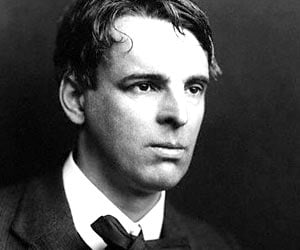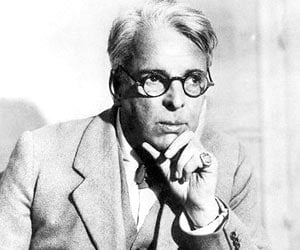W B Yeats
| Famous as | Poet & Dramatist |
| Born on | 18 June 1865 |
| Born in | Dublin, Ireland |
| Died on | 28 January 1939 |
| Nationality | Ireland |
Childhood & Education
William Butler Yeats was born on 18 June 1865 in County
Dublin, Ireland to John Butler Yeats, a Williamite soldier and linen
merchant and Susan Mary Pollexfen, daughter of a wealthy family from county
Sligo. His father was a supporter of nationalism and the nationalist
movement in the country. Initially wanted to be lawyer, John Butler was
studying law at the time of his marriage but abandoned the study and
moved to England in 1876, where he earned fame as a great painter and
died in 1922. William Butler's siblings, his brother Jack absorbed his
father's artistic talents, becoming one of the most regarded painter and
his two sisters Elizabeth and Susan became members of Arts and crafts
movement.
William's upbringing in his highly aristocratic family was sure to
have an impact on his life and poetry. Yeats' early years are marked by
events like rise of the Home rule movement and the momentum of
nationalism and a power shift away from the Protestant minority. These
events had a deep impact on the young Yeats' mind and would reflect in
his literary work. On 26 January 1877, William Yeats was sent to the
Godolphin primary school where he studied for the next four years. All
along his schooling, Yeast showed a particular interest in zoology and
biology but failed to achieve anything of distinction. The most
astonishing part of his education remains the fact that he did
remarkably poor in mathematics and languages as a student.
In 1881, Yeats enrolled into Erasmus Smith High School, Dublin and
wrote his first poem and essay The Poetry of Samuel Ferguson in 1885.
The poem was first published in the Dublin University Review. In 1884,
William Yeats joined the Metropolitan School of Art (the National
College of Art and Design), studying art till 1886. During this period,
he wrote his first individual piece, a poem depicting a magician. Since
then he started writing poems on various themes and plays. His initial
works were deeply influenced with the creations of great poet P.B.
Shelly, and later shifted towards pre-Raphaelite verse and Irish myth
and traditions. In his maturing years, Yeats came to appreciate the
writing of William Blake.
Early career & Life
In 1887, Yeats and his family returned to London where he
established the Rymer's Club, a group of poets in 1890. The group, later
known as the "Tragic generation" released two anthologies in 1892 and
1894. Yeats' remarkable interest in mysticism, spiritualism, astrology
and occultism drew criticism from his contemporaries who termed it as a
lack of intellectuality. His first serious work, The Isle of Statutes,
was a fantasy poem and was published in Dublin University Review. In
1886, he published a pamphlet Mosada: A Dramatic Poem followed by
another collection The Wanderings of Orisin and Other Poems, published
in 1889.
The Wanderings of Orisin was his first and probably the most
extensive work, as he never attempted another. The poem was largely
based upon the struggle of life, a theme that would frequently appear in
his future works. During this period, he also wrote Poems (1895), The
Secret Rose (1897) and The Wind Among the Reeds (1899).
In 1885, Yeats became a co founder of the Dublin Hermetic Order and as a
result, was made its chairman. At that time, he was also involved in
the Theosophical Society and with Hermeticism.
Maud Gonne
In 1889, Yeats met Maud Gonne, a poet, feminist and a fervent
nationalist. Yeats became increasingly passionate about her who became
his muse and source of unrequited love. He proposed marriage to her at
least three times; in 1899, 1900 and 1901 and was rejected each time
which was probably a result of his lack of enthusiasm to contribute in
the revolutionary movement. In 1903, Maud married a nationalist
revolutionary Major MacBride, who was later executed by British forces.
Even though, they continued their friendship and Maud remained his
inspiration and an immense impact on his life. In 1908, their
relationship was finally consummated as he recalls the event in his poem
A Man Young and Old. However, it did not help the relationship flourish
beyond friendship and she finally turned down his last proposal in
1916.
Marriage & Family
On 20 October 1917, Yeats married a friend George Hyde Lees whom he had met in 1911 at the age of 51. She shared Yeats’ interest in mystical and esoteric subjects and helped him with the automatic writing. Despite a huge age difference the marriage
proved happy and the couple had two children; daughter Anne, born in
1919 and son Michael, born in 1921. Yeats wrote two poems "A Prayer for
My Daughter" and "A Prayer for My Son"
for them. George proved to be good wife and helped him with his
creations; among them is A Vision, a book elucidating his philosophy and
use of symbolism which was published in 1921.
Abbey theatre and Later Work
In 1899, Yeats co founded the Irish Literary Theatre in Dublin
which was to be a platform for the Celtic and Irish plays. As its chief
dramatist, one of the first plays performed there was his Catheleen ni
Houlihan, with Gonne portraying the main character. The theatre, which
was also known as the National Theatre of Ireland, opened in 1904, and
soon became the flagship for the young talent of Ireland. His other
works which gained him praise as a dramatist include The Countess Cathleen (1892), The
Land of Heart’s Desire (1894) and The King’s Threshold (1904). In 1911,
the Abbey Theatre set on a tour to the United States. In 1903, Yeats
embarked on his first lecture tour to the United States followed by his
second, third and fourth trip in 1914, 1920 and 1932 respectively. In
1904, Yeats founded the Cuala Press with the help of his sister.
Nobel Prize, Later Years & Death
In 1923, Yeats was honored the Nobel Peace Prize for his immense
contribution to the English and Irish literature. In 1922, he was
appointed to the first Irish Senate and was consecutively reelected for
the second term in 1925. In the same year his book A Vision was
published. In 1924, a coinage committee appointed him as its chairman
for the selection of the first currency of Irish Free State and took
retirement from the senate in 1928. Yeats was a fervent supporter of
republicanism for all his life, but towards the end of his life, he
became cynical about the effectiveness of a democratic form of
government. At times, he also showed praise for the dictator Benito
Mussolini, though he refrained from fascism in his later years.
Yeats underwent a Steinach operation in 1934 and despite his severe
illness, took the editorship of the Oxford Book of Modern Verses in
1936. He passed away on 28 January 1939 in Menton, France and was buried
at Roquebrune-Cap-Martin. Keeping with his wishes, he was removed from
there and was reentered in Drumcliffe, County Sligo in 1948.
| ||||
Timeline: | ||||
1865- William Butler Yeats was born on 18 June.
1876- His family moved to England.
1877- William Yeats was sent to the Godolphin primary school.
1881- Yeats enrolled into Erasmus Smith High School.
1884- William Yeats joined the Metropolitan School of Art.
1885- He wrote his first poem and essay The Poetry of Samuel Ferguson.
1887- Yeats and his family returned to London.
1889- Yeats met Maud Gonne.
1890- He established the Rymer's Club, a group of poets.
1899- Yeats co founded the Irish Literary Theatre in Dublin.
1904- The theatre opened.
1904- Yeats founded the Cuala Press with the help of his sister.
1911- The Abbey Theatre set on a tour to the United States.
1917- Yeats married George Hyde Lees.
1919- His daughter Anne was born.
1921- Their son Michael was born.
1922- His father died.
1922- he was appointed to the first Irish Senate.
1925- He was reelected to the Senate.
1923- Yeats was honored the Nobel Peace Prize.
1924- A coinage committee appointed him as its chairman.
1928- Yeats took retirement from the Senate.
1934- Yeats underwent a Steinach operation.
1939- William Yeats passed away on 28 January.
1948- He was removed from there and was reentered in Drumcliffe, County Sligo.
|










0 comments:
Post a Comment